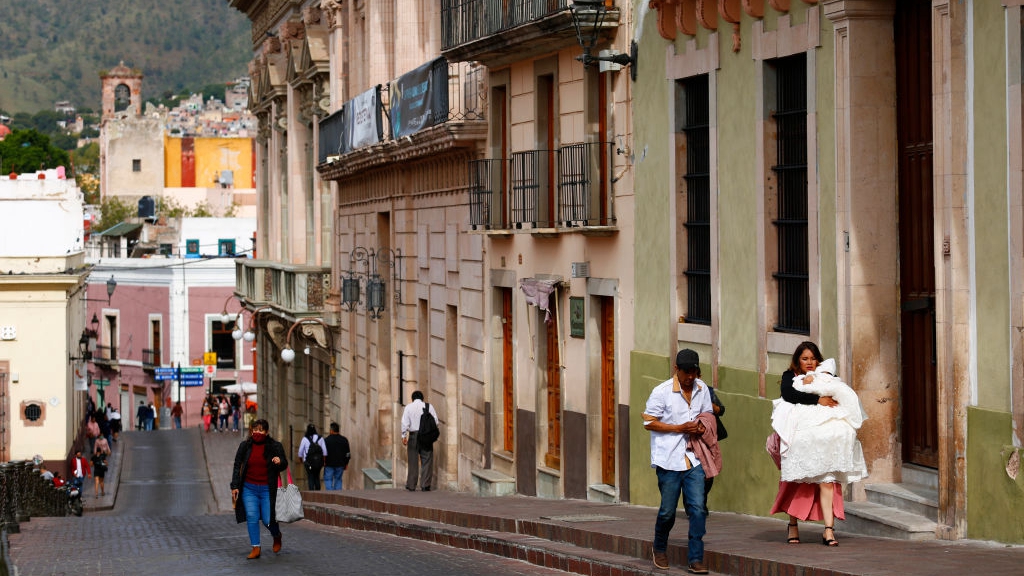
View of a street in Guanajuato, Mexico, October 16, 2021. /Getty
View of a street in Guanajuato, Mexico, October 16, 2021. /Getty
Editor's note: Andrés Velasco, a former presidential candidate and finance minister of Chile, is Dean of the School of Public Policy at the London School of Economics and Political Science. The article reflects the author's opinions and not necessarily the views of CGTN.
Latin Americans have many talents. One is a remarkable ability to misgovern ourselves, as the pandemic has made clear. Six of the 20 countries with the most COVID-19 deaths per capita in the world are in Latin America. Peru tops the list. Brazil is eighth.
Yes, poverty, a shortage of hospital beds, and overcrowded housing all helped the virus spread, but those factors alone cannot explain why the region has done so badly. Many countries in Asia and Africa suffer from the same problems but have fewer deaths per capita. Even countries that vaccinated people early, like Chile – or which, like Uruguay, were held up as successes when the virus first hit – have ended up mediocre performers.
Latin America is once again getting ready to lead the world - this time, in post-pandemic economic failure. The region enjoyed a couple of quarters of vigorous recovery, fueled by high commodity prices, but the engine of growth is already sputtering in several countries. The International Monetary Fund expects Latin America to be the world's slowest-growing region in 2022.
Even worse, the losses look set to be permanent, with the IMF's just-released report on the region concluding that it will probably never return to the path for per-capita income envisaged before the pandemic. By contrast, the Fund projects that advanced economies will soon converge to their pre-virus trajectories.
Standard economic growth theory maintains that poor countries should gradually catch up with the rich. Latin America is the exception that confirms the rule: for the foreseeable future, it will fall even further behind.
In the past, the region's economy suffered whenever commodity prices fell. This time around, it will suffer during what looks like a commodity mini-boom. Part of the reason is that slow growth in productivity and income are longstanding problems.
From the 1970s to the 1990s, Latin America missed the boat of export-oriented manufacturing that made East Asia rich. In the 21st century, it missed the boom in supply chains that benefited countries from Bulgaria to Vietnam. Mexico is tightly bound to North American supply chains. The large South American economies of Argentina, Brazil, and Colombia are not.
Economic scarring from the pandemic threatens to weaken long-term growth performance further. Thanks to the spectacularly selfish behavior of teachers' unions, which refused to re-open schools long after workers in other sectors had returned to their jobs, Latin American pupils were kept away from the classroom for an average of 48 weeks during the pandemic.
In other emerging and developing economies, the figure was only 30 weeks. Privileged kids with access to broadband kept learning from their homes; poor kids did not. The impact on Latin American productivity will last for decades - and make income inequality worse.
A collapse in investment is also pushing down growth. A recent survey in Chile revealed that 70 percent of companies have put their expansion plans on hold. The reasons are not hard to fathom. In the same week the survey was conducted, downtown Santiago was vandalized, while Chileans learned that a far-right candidate had joined an extreme left-winger atop opinion polls ahead of the presidential election on November 21.
Latin America has long suffered from left-wing populism. Nicolás Maduro in Venezuela, Rafael Correa in Ecuador, and the Kirchners (husband and widow) in Argentina have excelled at portraying themselves as the people's only true representative – and then proceeding to weaken the democratic institutions that could hold them accountable for their disastrous policies.
Now the region is also plagued by right-wing populism. Jair Bolsonaro in Brazil, some of Álvaro Uribe's disciples in Colombia, and José Antonio Kast in Chile are reciting the same Trumpian script: law and order, anti-immigrant nationalism and anti-woke cultural warfare.

View of a flag with the face of Brazilian President Jair Bolsonaro during a demonstration in favor of his government amidst the COVID-19 pandemic in Brasilia, Brazil, June 9, 2020. /Getty
View of a flag with the face of Brazilian President Jair Bolsonaro during a demonstration in favor of his government amidst the COVID-19 pandemic in Brasilia, Brazil, June 9, 2020. /Getty
Chile, Brazil, and Colombia will soon hold presidential polls whose second rounds will likely pit a right-wing King Kong against a left-wing Godzilla. In the movie, the two monsters' clash left only destruction. The same could well happen in Latin America.
Moreover, while the pandemic may be ending, the specter of a debt crisis looms. The good news is that most countries did not lose market access, so governments and firms could keep borrowing to get over the pandemic hump. The bad news is that they now have to live with the consequences.
Much higher public and private debt, shortening maturities, and rising world interest rates are a toxic combination. In several countries - including Brazil and Argentina - government debt ratios are already worryingly high. Faster-than-expected monetary tightening by the U.S. Federal Reserve could set the stage for the kinds of debt runs and rollover crises that have often beset the region. Yet, for all its woes, Latin America can begin growing again if it seizes two opportunities. One is the re-shoring prompted by the pandemic and by rising tensions between China and the West.
And if the more advanced South American economies improve their ports and roads, and manage to keep their finances reasonably stable, they could benefit as well. This is their second (and perhaps last) chance to catch the supply chain boat they first missed a generation ago.
Greater investment in green infrastructure could also help. Multilateral lenders will be looking to finance projects in any shade of green, and the region should take full advantage of it. The trick will be to increase investment while adding as little as possible to the region's public-debt burden. In low-income countries, grants should play the central role. And for middle-income countries, equity inflows, private-public partnerships, and other kinds of innovative financing arrangements should take center stage.
According to the Inter-American Development Bank, Latin American governments can make room for green investment if they cut regressive expenditures. That is right, but easier said than done. Powerful players often strongly desire undesirable expenditure. Regressive and eco-unfriendly energy subsidies are an example. Just ask politicians in Argentina and Ecuador who have struggled to eliminate them.
"Brazil is the country of the future and always will be," goes the old adage. Nowadays, too many other poorly governed Latin American countries are courting the same destiny.
Copyright: Project Syndicate, 2021.
(If you want to contribute and have specific expertise, please contact us at opinions@cgtn.com.)

